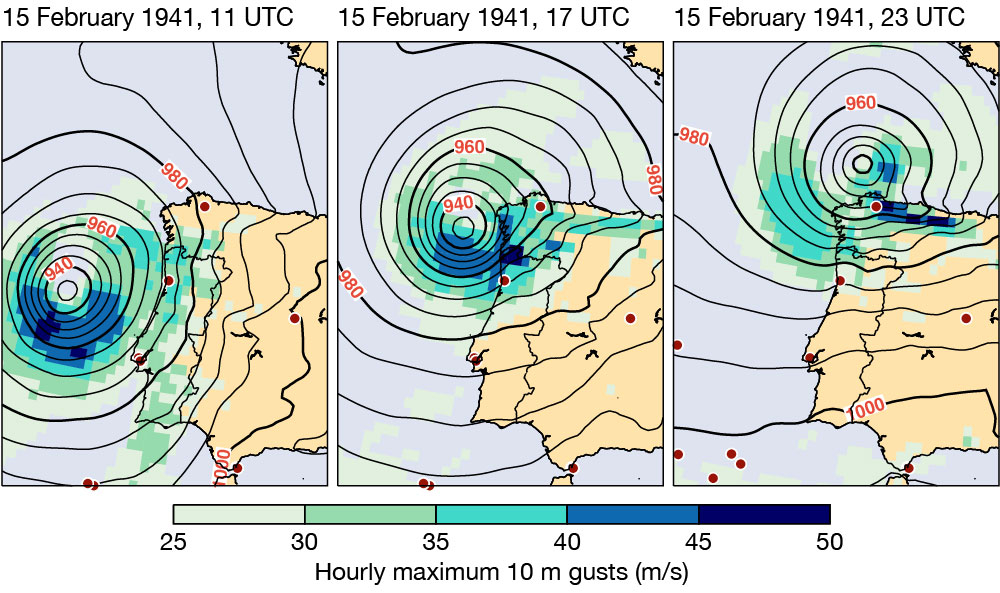On 7 March 2023, ERA5 reanalysis data for 1940 to 1958 were made publicly available from the Climate Data Store (CDS) of the EU’s Copernicus Climate Change Service (C3S) implemented by ECMWF. Authorised users can also access those years in ECMWF’s Meteorological Archival and Retrieval System (MARS). This release extends the data record to over 83 years of hourly global snapshots for many quantities that describe the global atmosphere, land surface and ocean waves, from 1940 to the present. At a horizontal resolution of about 31 km, ERA5 provides detailed information on historical weather and climate. It has attracted a diverse and rapidly growing user base with over 100,000 registered users.
The additional 19 years of the new release were produced during 2022 in four parallel streams on ECMWF's high-performance computing facility (HPCF) in Reading, UK. They were completed just before the HPCF was decommissioned in October 2022. In addition, the suite that delivers timely updates was ported to ECMWF’s new facilities in Bologna, Italy. It continues to add one day per day to the ERA5 record, five days behind real time. The ERA5-Land suite, which provides a downscaled land product at a resolution of 9 km, was also ported. A service of timely updates to ERA5-Land, similar to the updates to ERA5, was introduced on 16 December 2022.
ERA5 final release data were already available from 1959 onwards. The current further extension to 1940 replaces a preliminary extension back to 1950 that was characterised by sub-optimal tropical cyclone properties.
The role of observations
Like the analysis that is computed to initialise ECMWF operational forecasts, the ERA5 reanalysis blends observations with the ECMWF numerical weather prediction model into globally complete fields using the 4D‑Var data assimilation method. The main differences are that ERA5 uses a frozen weather forecasting system throughout (as operational in 2016) for reasons of consistency, and it uses a lower resolution than the one used in operational weather forecasting to keep the system affordable. In contrast to longer centennial reanalyses, which ingest only surface observations, ERA5 makes use of all available observations, in‑situ and from satellites. In addition, ERA5 includes observations from the latest instruments as they are used in ECMWF’s medium-range weather forecasting system, where possible.
The ability to reconstruct the actual historical weather depends on the availability of observations. In the past, the observing system was sparser than today. In addition, many observations are not yet available in digital form. In ERA5, no satellite data were used before 1970. The in‑situ observing system was sparse over the southern hemisphere, and before the mid‑1940s no upper‑air observations were available. Nevertheless, from 1940 ERA5 should provide a good estimate of the actual synoptic situation for large regions over the northern hemisphere. An example (shown in the figure) is the representation of a severe storm over the Iberian Peninsula 82 years ago, which led to significant damage and disruption over Portugal and northwest Spain.

The spread in ERA5 ensembles provides a guide to the accuracy of such synoptic situations. It can also be used to know when and where ERA5 is dominated by observations, and where it is more controlled by the model. In the latter case, it should still be able to give a good description of low-frequency variability.
On the seasonal timescale, surface temperature for the ERA5 back extension is in good agreement with reconstructions that are solely based on observational sources on sub-daily to monthly aggregations. On the yearly scale, there is less agreement in global mean temperature for the early 1940s, while the lack of upper-air observations in these years also exposes a model cold bias in the lower stratosphere. Agreement is much better from the mid- to late-1940s onwards. Overall, the ERA5 back extension provides an excellent extension of the power of reanalysis to provide ‘maps without gapsʼ.
The full ERA5 reanalysis can be accessed in the CDS: https://cds.climate.copernicus.eu/.
